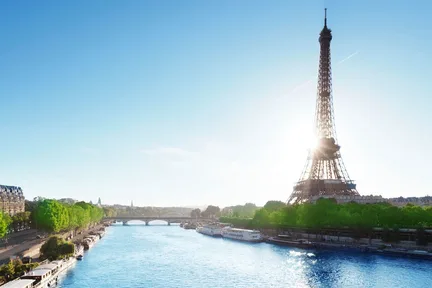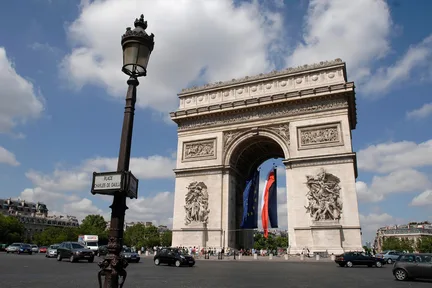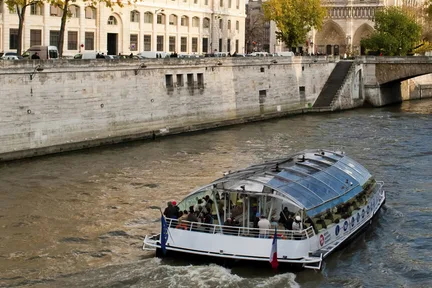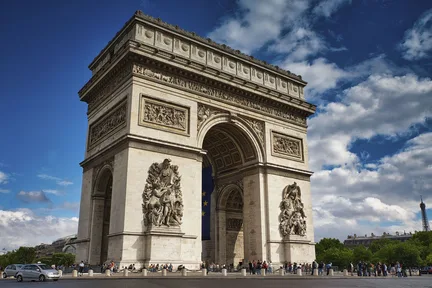Arc de Triomphe

The best of Arc de Triomphe
Bucket-list experiences
Make it a getaway
Events with a lot of buzz
Trouble-free transport
More to explore
Why people love Arc de Triomphe
Nearby places to go
FAQs about Arc de Triomphe
When is the best time to visit the Arc de Triomphe?
How can I get to the Arc de Triomphe using public transportation?
Do I need tickets to enter or climb the Arc de Triomphe?
How long is the visit to the Arc de Triomphe?
Is there an elevator at the Arc de Triomphe?
Is the Arc de Triomphe wheelchair accessible?
What should I know before visiting the Arc de Triomphe?
What to know before visiting Arc de Triomphe
Remarkable Landmarks and Must-Visit Sights
Arc de Triomphe
Built between 1806 and 1836, the Arc de Triomphe honors those who fought for France, especially during the Napoleonic Wars. This triumphal arch showcases intricate sculptures and engravings, including the names of generals and battles, and houses the Tomb of the Unknown Soldier from World War I. Standing at Place de l'Étoile, where the Champs-Élysées meets grand avenues, it symbolizes the strength and unity of French history and its victories.
Tomb of the Unknown Soldier
Located beneath the arch, the Tomb of the Unknown Soldier from World War I is a poignant tribute to those who died in the war. An eternal flame burns in memory of the unidentified soldiers, rekindled daily in a moving ceremony that attracts both locals and tourists. This act of remembrance is a key element of the Arc de Triomphe's cultural significance.
Axe Historique
The Arc de Triomphe is a central element of the Axe Historique, a historic axis that stretches from the Louvre to the Grande Arche de la Défense. As part of this line of monumental structures and grand thoroughfares, the Arc de Triomphe connects iconic landmarks in Paris, including the Eiffel Tower and Place de l'Étoile. This axis represents French unity and patriotism, making the Arc de Triomphe a linchpin in the city’s rich history.
Cultural and Historical Significance
The Arc de Triomphe stands as a powerful symbol of the French troops' courage, and its engravings of generals and battles celebrate the nation’s victories and its journey through times of conflict, such as the French Revolution and the Napoleonic Wars. A visit to this remarkable monument offers visitors not only an opportunity to reflect on France's history but also to enjoy great views of Paris from its terrace.
Architectural Marvel
Standing 49.5 meters tall and 45 meters wide, the Arc de Triomphe is a symbol of French pride. Its 19th-century sculptures, by artists like James Pradier, Antoine Etex, and Jean-Pierre Cortot, reflect Napoleon's empire and mark Place de l'Étoile at the center of Paris’ historic axis. The arch celebrates French victories throughout history.
Cultural Practices
The daily rekindling of the eternal flame at the Tomb of the Unknown Soldier is a poignant reminder of France's deep respect for its fallen heroes. This ceremony attracts both locals and tourists, providing a reflective moment amidst the hustle and bustle of the city, honoring those who fought for French freedom during the World War and beyond.
Nearby Attractions to Explore
Nearby attractions to the Arc de Triomphe include the iconic Champs-Élysées, leading to the Eiffel Tower, and the peaceful Tuileries Garden. The Grand Palais and Petit Palais host art exhibitions, while Les Invalides, home to Napoleon’s Tomb, offers rich history. Don’t miss the scenic Pont Alexandre III with stunning views of the Seine.
Local Cuisines
While visiting the Arc de Triomphe, take the opportunity to explore nearby dining options along the Champs-Élysées. Indulge in classic French dishes such as escargot, coq au vin, and crème brûlée at one of the many bistros and restaurants in the area, offering a true taste of Paris.



